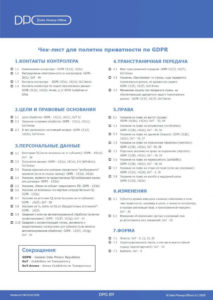(61) Informācija par datu subjekta personas datu apstrādi būtu tam jāsniedz datu ieguves no datu subjekta brīdī vai – ja personas datus iegūst no cita avota– saprātīgā termiņā atkarībā no lietas apstākļiem. Ja personas datus var leģitīmi izpaust citam saņēmējam, datu subjekts būtu jāinformē, kad personas dati tiek izpausti saņēmējam pirmo reizi. Ja pārzinis paredz personas datus apstrādāt citā nolūkā, kas nav nolūks, kādā tie tika vākti, pārzinim pirms minētās turpmākās apstrādes būtu jāinformē datu subjekts par minēto citu nolūku un jāsniedz tam cita vajadzīgā informācija. Ja datu subjektam nevar norādīt personas datu avotu tā iemesla dēļ, ka ir izmantoti dažādi avoti, būtu jāsniedz vispārīga informācija.
(61) The information in relation to the processing of personal data relating to the data subject should be given to him or her at the time of collection from the data subject, or, where the personal data are obtained from another source, within a reasonable period, depending on the circumstances of the case. Where personal data can be legitimately disclosed to another recipient, the data subject should be informed when the personal data are first disclosed to the recipient. Where the controller intends to process the personal data for a purpose other than that for which they were collected, the controller should provide the data subject prior to that further processing with information on that other purpose and other necessary information. Where the origin of the personal data cannot be provided to the data subject because various sources have been used, general information should be provided.
(62) Tomēr pienākumu sniegt informāciju nav vajadzīgs noteikt gadījumos, ja informācija jau ir datu subjekta rīcībā, ja personas datu reģistrācija vai izpaušana ir skaidri paredzēta likumā, vai ja informācijas sniegšana datu subjektam izrādās neiespējama vai prasītu nesamērīgi lielas pūles. Pēdējais minētais varētu jo īpaši būt gadījums, kad apstrāde tiek veikta arhivēšanas nolūkos sabiedrības interesēs, zinātniskās vai vēstures pētniecības nolūkos, vai statistikas nolūkos. Minētajā sakarā būtu jāņem vērā datu subjektu skaits, datu vecums un jebkādas pieņemtās atbilstošās garantijas.
(62) However, it is not necessary to impose the obligation to provide information where the data subject already possesses the information, where the recording or disclosure of the personal data is expressly laid down by law or where the provision of information to the data subject proves to be impossible or would involve a disproportionate effort. The latter could in particular be the case where processing is carried out for archiving purposes in the public interest, scientific or historical research purposes or statistical purposes. In that regard, the number of data subjects, the age of the data and any appropriate safeguards adopted should be taken into consideration.
(63) Datu subjektam vajadzētu būt tiesībām piekļūt personas datiem, kas par to savākti, un viegli un saprātīgos intervālos īstenot minētās tiesības, lai zinātu par apstrādi un pārliecinātos par tās likumīgumu. Tas ietver arī datu subjektu tiesības piekļūt saviem veselības datiem, piemēram, datiem par slimības vēsturi, kas ietver tādu informāciju kā diagnozes, analīžu rezultāti, ārstējošā terapeita vērtējums un ārstēšanas vai medicīniskās iejaukšanās pasākumi. Tāpēc katram datu subjektam vajadzētu būt tiesībām zināt un saņemt paziņojumu jo īpaši par to, kādos nolūkos personas datus apstrādā, ja iespējams, cik ilgi personas dati tiek apstrādāti, personas datu saņēmējus, kāda ir jebkurā personas datu automātiskajā apstrādē ietvertā loģika un kādas ir šādas apstrādes sekas – vismaz tad, ja apstrāde pamatojas uz profilēšanu. Ja iespējams, pārzinim būtu jāspēj nodrošināt attālināta piekļuve drošai sistēmai, kas datu subjektam sniegtu tiešu piekļuvi saviem personas datiem. Minētajām tiesībām nevajadzētu nelabvēlīgi ietekmēt citu personu tiesības vai brīvības, tostarp tirdzniecības noslēpumus vai intelektuālā īpašuma tiesības un jo īpaši autortiesības, ar ko aizsargāta programmatūra. Tomēr minēto apsvērumu rezultātam nevajadzētu būt tādam, ka datu subjektam tiek atteikts sniegt jebkādu informāciju. Ja pārzinis apstrādā lielu informācijas apjomu saistībā ar datu subjektu, pārzinim būtu jāspēj pieprasīt, lai datu subjekts pirms informācijas nosūtīšanas precizētu, uz kuru informāciju un kurām apstrādes darbībām pieprasījums attiecas.
(63) A data subject should have the right of access to personal data which have been collected concerning him or her, and to exercise that right easily and at reasonable intervals, in order to be aware of, and verify, the lawfulness of the processing. This includes the right for data subjects to have access to data concerning their health, for example the data in their medical records containing information such as diagnoses, examination results, assessments by treating physicians and any treatment or interventions provided. Every data subject should therefore have the right to know and obtain communication in particular with regard to the purposes for which the personal data are processed, where possible the period for which the personal data are processed, the recipients of the personal data, the logic involved in any automatic personal data processing and, at least when based on profiling, the consequences of such processing. Where possible, the controller should be able to provide remote access to a secure system which would provide the data subject with direct access to his or her personal data. That right should not adversely affect the rights or freedoms of others, including trade secrets or intellectual property and in particular the copyright protecting the software. However, the result of those considerations should not be a refusal to provide all information to the data subject. Where the controller processes a large quantity of information concerning the data subject, the controller should be able to request that, before the information is delivered, the data subject specify the information or processing activities to which the request relates.













ISO/IEC 27701, принятый в 2019, добавил дополнительное руководство к ISO/IEC 27002 для контролеров персональных данных (ПИИ).
Приводим соответствующий параграф к статье 13(2)(a) GDPR:
7.4.7 Хранение
Средство управления
Организация должна хранить ПИИ не дольше, чем это необходимо для целей, для которых ПИИ обрабатывается.
Руководство по внедрению
Организация должна разработать и поддерживать графики хранения информации, которую она хранит, принимая во внимание требование сохранять ПИИ не дольше, чем это необходимо.
…
Войти
для доступа к полному тексту